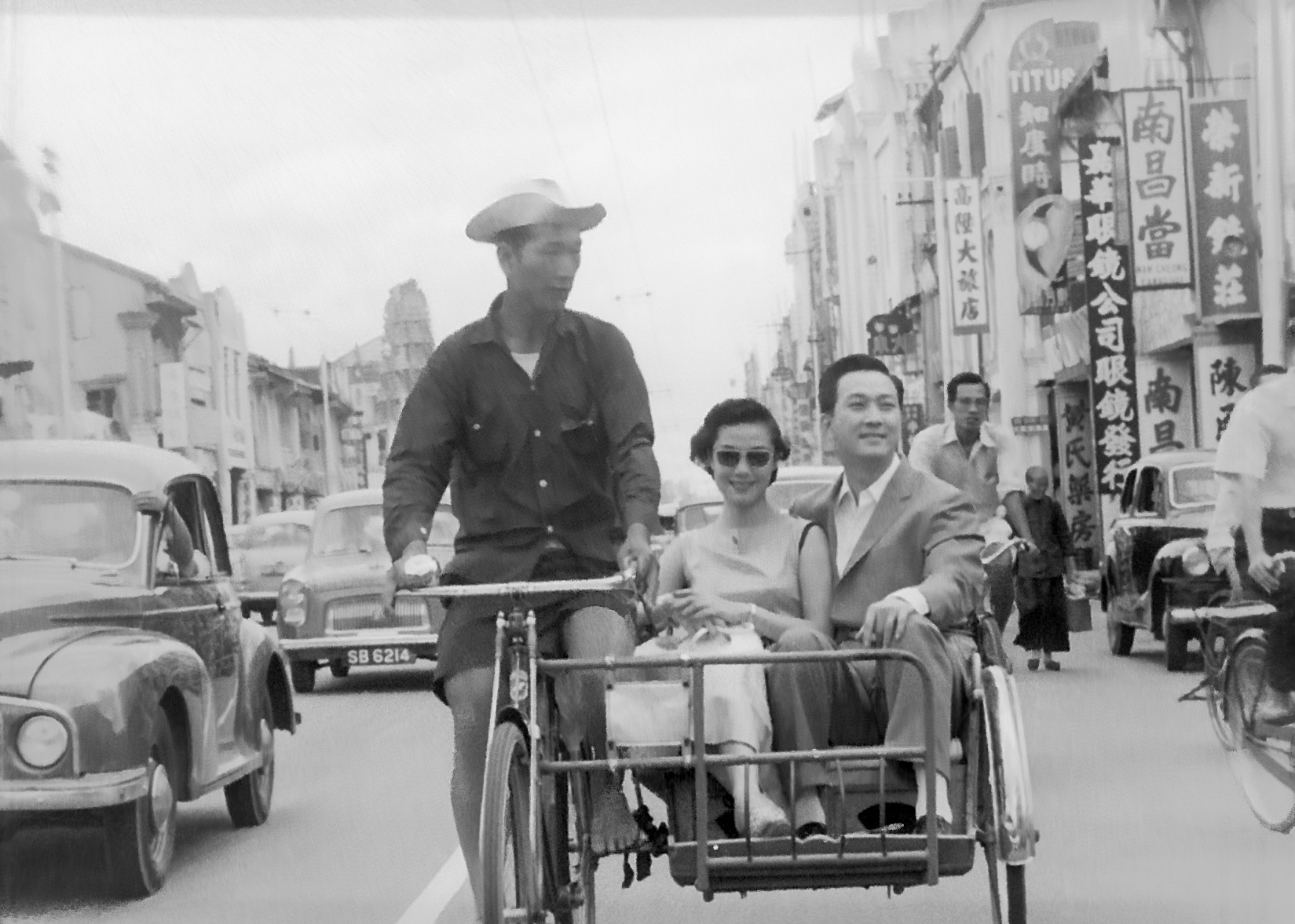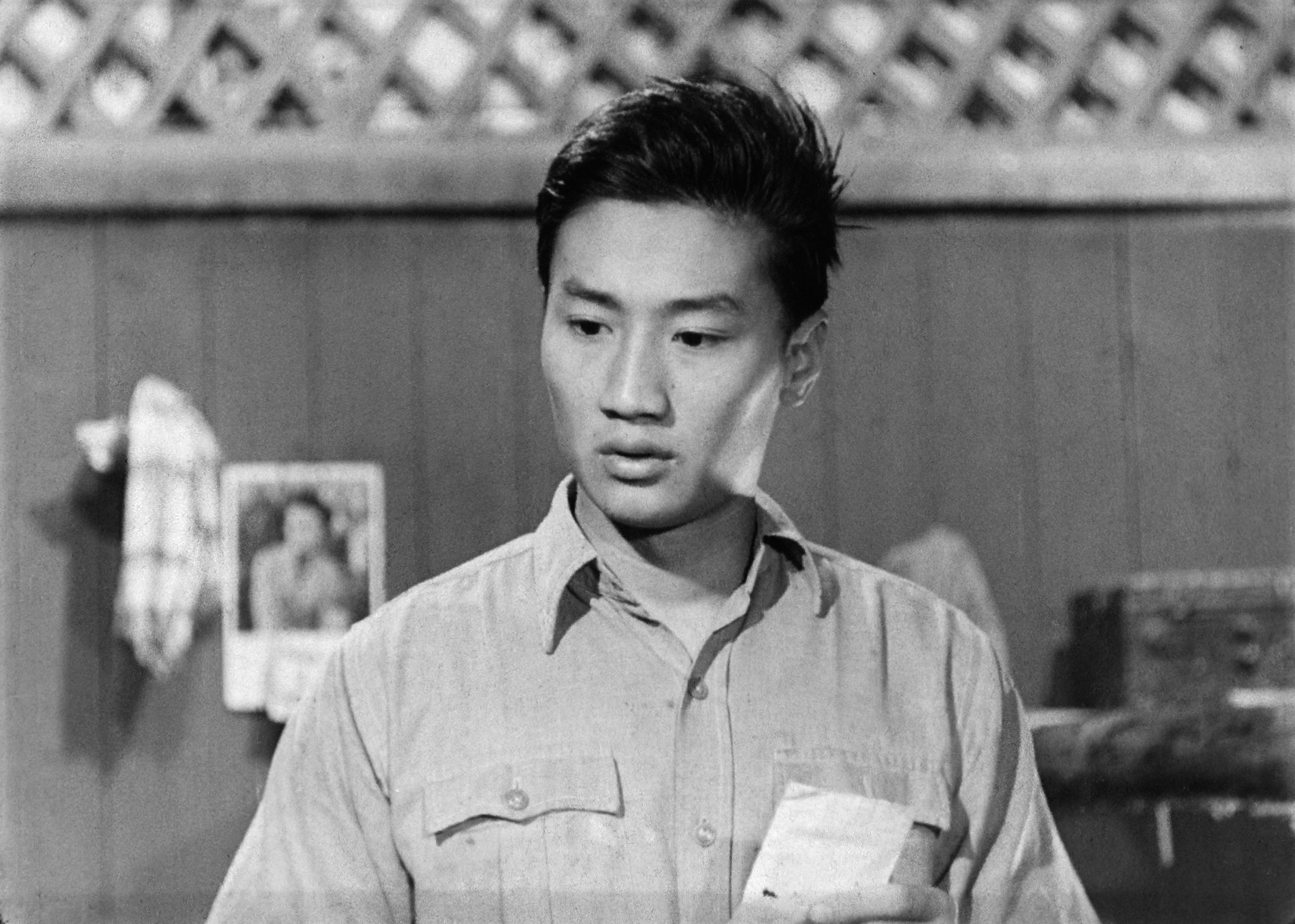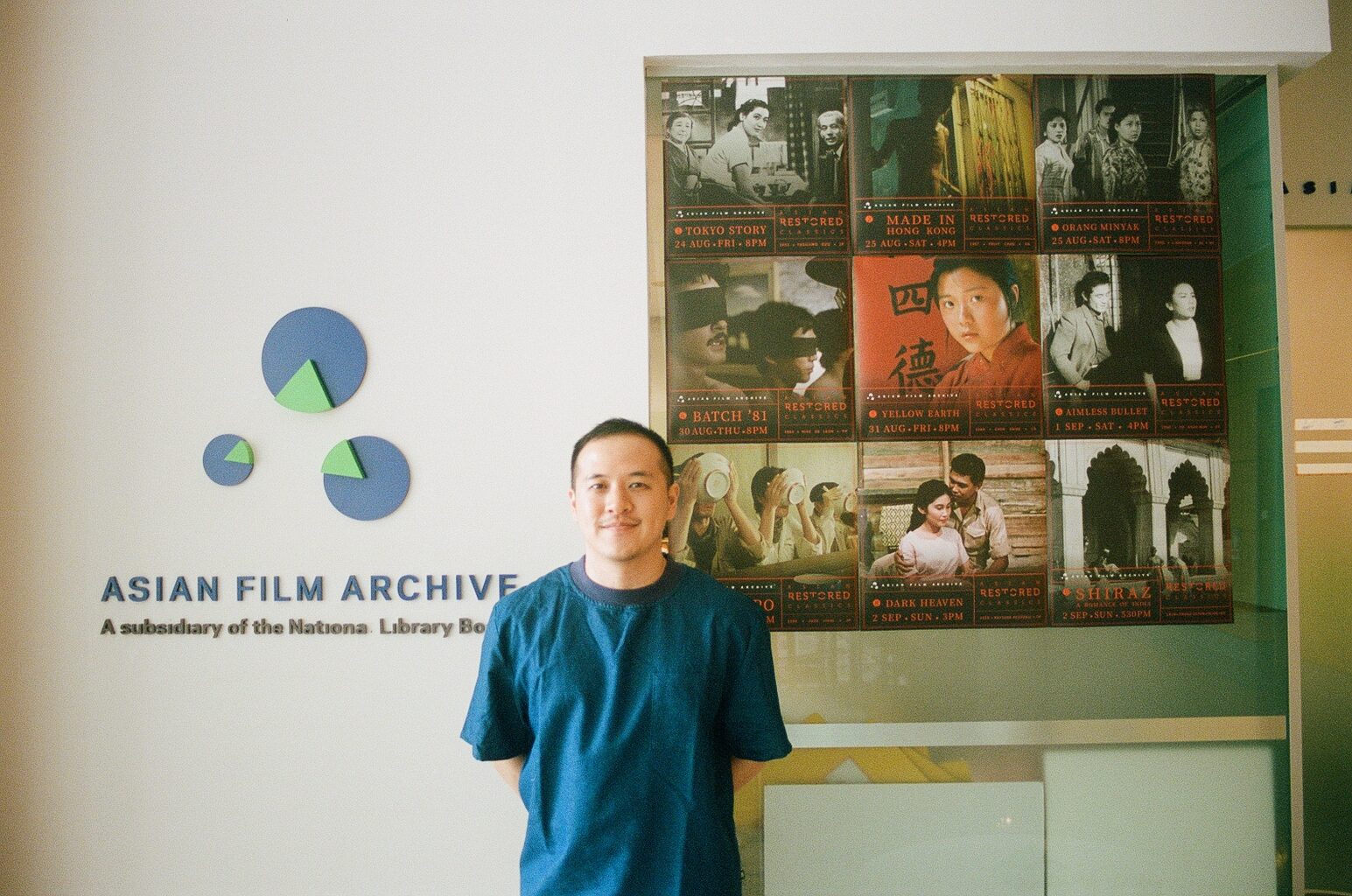The Nanyang Trilogy (南洋三部曲) is a series of three films, produced by Kong Ngee Motion Picture Production Company in 1957. The three films are Moon Over Malaya (椰林月), China Wife (唐山阿嫂), and Blood Stains the Valley of Love (血染相思谷). It was lovingly restored by the Asian Film Archive, and was recently the subject of a roving exhibition by the archive.
Chew Tee Pao is the Archivist at the Asian Film Archive. He works to strategise the Archive’s preservation and outreach programmes and promotes its advocacy efforts. Tee Pao has written articles on film preservation and contributed a chapter on “Independent digital filmmaking and its impact on film archiving in Singapore” for the book Singapore Cinema: New Perspectives.
Chew Tee Pao is the Archivist at the Asian Film Archive. He works to strategise the Archive’s preservation and outreach programmes and promotes its advocacy efforts. Tee Pao has written articles on film preservation and contributed a chapter on “Independent digital filmmaking and its impact on film archiving in Singapore” for the book Singapore Cinema: New Perspectives.
Trailer for Nanyang Trilogy RESTORED
CONTEXT & SIGNIFICANCE
Chew Tee Pao (CTP): The Nanyang Trilogy are a series of Cantonese films produced by the Kong Ngee Motion Picture Production Company. After Cathay-Keris and Shaw Brothers, Kong Ngee Company was the third largest player in the Singaporean film industry. For the most part, Kong Ngee’s contributions to the Singaporean film industry have been largely overlooked. This is mostly because the company produced films in Mandarin and dialect languages, and their production arm was later moved to Hong Kong.
All three movies were made in 1957, and the entire Hong Kong-based cast and film crew flew to Singapore and Malaysia to film. This was pre-independence, so the film explores multiple sites and themes that are significant to the Chinese diaspora — immigrants who came from Nanyang, and settled in Southeast Asia.
Moon Over Malaya, Kong Ngee Motion Picture Production Company
Asian Film Archive, 1957
Credit: Asian Film Archive
Asian Film Archive, 1957
Credit: Asian Film Archive


RESTORING THE FILM
CTP: We began partially restoring Moon Over Malaya in 2010, and it was in the collection of the Hong Kong Film Archive. It is one of three films in the Nanyang Trilogy. The restoration was done pro-bono for our anniversary celebrations. In 2014, it came to our attention that the partially restored version of Moon Over Malaya was one of two editions of the same film. The version the archive worked on was a shorter version shot on 35mm film, however the Hong Kong Film Archive also held a 16mm version that was about twenty minutes longer. We decided to work on both the 35mm and the 16mm version, and in doing so, decided to work on the remaining two films in the trilogy as well. In a sense, it was our way of bringing that slice of history back to Singapore. Although it is a part of Hong Kong’s history, it was clear that the film was significant to Singapore as well. We completed the project sometime last year, and released the films on DVD and Blu-Ray with accompanying articles.
The restoration was done with limited elements. With Moon Over Malaya, the Hong Kong Film Archive had two copies — 35mm and 16mm. However with the other two films in the trilogy, China Wife and Blood Stains the Valley of Love, there was only one copy of 16mm film each to work with. The films were not in great shape, but we decided to take them out on loan anyway.
We outsourced the actual restoration of the films as the tasks required a very specialised set of skills. The restorers cleaned and repaired the prints, scanning them in 4K resolution and manually restoring the film using the digital scans. Although everything is digitally screened and accessed nowadays, we didn’t want to restore the films for the sole purpose of screening them. We printed the restored films on celluloid film again because when it comes to preservation, physical film remains the most stable form.
We haven’t really encountered a situation yet where language has been an issue for us in restoring a film. When we work on a film, we work towards creating subtitles for it as well. In cases where subtitles do not come with the film, we engage a translator to help us with the cataloguing process. However, sometimes films come to us with damaged sound waves or pictures. When we watched an unrestored version of the Nanyang Trilogy, some of the scenes were really dark due to the reel’s poor condition. The restoration helped to reveal some parts of the film that were previously obscured, including a scene of the characters walking on the Merdeka Bridge. This really evidenced the importance of that work, which is really interesting for us. When a print is brightened, scratches are cleaned and mould is removed, images are recovered. The shot of the characters walking on the bridge carried a lot of meaning for the film, so it was important that it was seen by viewers.
We also go through a process of selecting the right restorer for us, and we don’t always work with the same restorers as well. With the Nanyang Trilogy, we worked with a restorer that specialised in classic films. The restorers made it clear to us that they were not looking to enhance or improve how an image was meant to be. Restoration is not about enhancing or improving sound or an image by making it more beautiful. It’s about bringing it as close to the originally intended screen projection as possible. We were all on the same page with regard to this, and we constantly reviewed the restorer’s process as well. We were really lucky to have worked with this group of restorers on this film. They work primarily with black and white films, that can be rather difficult to handle as well. When reviewing the film, there have been instances where we felt the films colours were overly enhanced. However, these have been with films that were so faded to the point of turning magenta-toned. In order to bring the film’s colours out again, we understood that it had to be pushed a little. Our goal is not to enhance, so we do try to draw a balance with that.
China Wife, Kong Ngee Motion Picture Production Company
Asian Film Archive, 1957
Credit: Asian Film Archive
Asian Film Archive, 1957
Credit: Asian Film Archive


AFTER RESTORATION
CTP: After restoration, we were able to look at the films with a fresh pair of eyes. Having worked on the shorter version of Moon Over Malaya, I thought I knew the film quite well. However, discovering the 16mm version added twenty minutes to the film. Immediately, I noticed how the film’s character and depth was enhanced. With the longer version, a lot of things made more sense because there was now more room for development. We’re not quite sure how the shorter version came about, but we suspect it was made for television. Scenes that dragged on a bit were edited out. In retrospect, the shorter version seemed a little abrupt, but you can see why the film was edited it the way it was.
We did a travelling exhibition on the films, Nanyang Trilogy RESTORED. We worked with researchers to identify the movie’s filming locations, and included photographs of how these sites looked like previously and how they look like now in the exhibition. The exhibition only provides a brief overview of the film, but we've included information about the Kong Ngee Company and how these three films were made.
In a way, I think we’ve come full circle with this film. We started out restoring just one film out of the trilogy, and we’ve now screened the films multiple times. Looking back, being able to work on all three films has been quite a meaningful project for us.
Blood Stains the Valley of Love, Kong Ngee Motion Picture Production Company
Asian Film Archive, 1957
Credit: Asian Film Archive
Moon Over Malaya, Kong Ngee Motion Picture Production Company
Asian Film Archive, 1957
Credit: Asian Film Archive
Asian Film Archive, 1957
Credit: Asian Film Archive
Moon Over Malaya, Kong Ngee Motion Picture Production Company
Asian Film Archive, 1957
Credit: Asian Film Archive


THE ASIAN FILM ARCHIVE
CTP: The Asian Film Archive was founded in 2005 as a non-profit, independent organisation. Our Founder, Tan Bee Thiam, felt that the Southeast Asian region was lacking in terms of film archives. During his travels around the region, he realised that only a few national film archives were based in Southeast Asia. That’s how the archive came about — it started from one person. The archive has since come a long way, but we continue to work within a small team.
Our collection focuses on Singaporean films, and these make up the majority of our holdings. We also collect Southeast Asian films, particularly from countries, such as Malaysia, who do not have their own film archive. At the same time, we also collect films that sometimes fall between the cracks. For example, the Vietnam Film Institute is an established national institution that collects and preserves Vietnamese films. Every time a film is screened in Vietnam, the film is submitted to the authorities for a rating and classification. From there, the institute automatically collects the classified film. This means that the institute’s collection only houses the censored or edited versions of these Vietnamese films, and not the uncut edition. Films such as these fall into our purview. Some independent producers have also deposited their collections with us, instead of national collections, due to a variety of reasons.
Our collection is also contemporary, and most of our films were made over the past thirty years. However, we’ve also built up a substantial collection of classic films. For example, we have the entire surviving collection of Cathay-Keris Malay Classics. These are Malay films that were made in the 1950’s or 1960’s. These films had a UNESCO Memory of the World (Asia Pacific) status ascribed to them in 2014, and this was the first Singaporean entry to make the list for documentary and audio visual materials. Since then, we’ve been going through our collection to see how we can repurpose and relook these old films. We’ve also began digitising films that were previously only available as negatives. With the help of researchers and other film archives, we’ve also started to look overseas, where we’ve discovered a lot of Singaporean materials.
As an archive, we don’t just want to screen these restored films. We’re also actively engaged in looking for ways in which these films can be repurposed to reach out to different audiences. One of the programmes we organise on an annual basis is State of Motion. Based on a selected group of old films about a particular theme, we hold tours and commission contemporary visual artists to create works in response to specific filming sites. Old films can sometimes be unappealing for younger audiences. For them, libraries and archives are associated with old things. What we want to do is to bring these historical films to them through these programmes, and to, in turn, get people interested in the films themselves. We don’t just want to restore films and screen films. We want to put them into context and generate interest about these films.

Related Publications:
1. Asian Film Archive. Nanyang Trilogy 南洋三部曲. Singapore: Asian Film Archive, 2018.
2. Asian Film Archive. Asian Film Archive >10. Singapore: Asian Film Archive/Marshall Cavendish, 2016.
3. Liew, Kai Khiun and Stephen Teo, eds. Singapore Cinema: New Perspectives. Singapore: Routledge, 2016.
1. Asian Film Archive. Nanyang Trilogy 南洋三部曲. Singapore: Asian Film Archive, 2018.
2. Asian Film Archive. Asian Film Archive >10. Singapore: Asian Film Archive/Marshall Cavendish, 2016.
3. Liew, Kai Khiun and Stephen Teo, eds. Singapore Cinema: New Perspectives. Singapore: Routledge, 2016.
